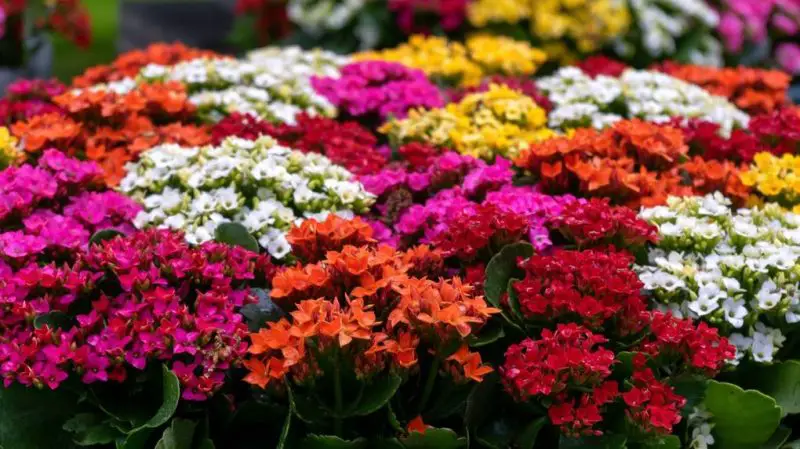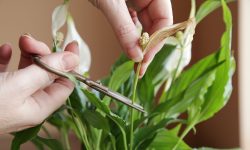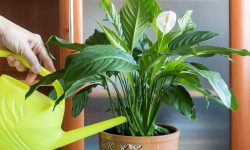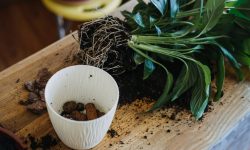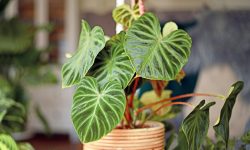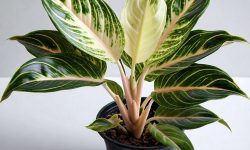Kalanchoe is one of the most attractive and low-maintenance succulents you can grow indoors. With its vibrant clusters of flowers and thick, glossy green leaves, this plant adds a cheerful burst of color to any room. It’s also a great choice for busy plant lovers thanks to its drought-tolerant nature. However, to keep your kalanchoe blooming regularly and looking healthy year-round, proper care techniques—including light, soil, watering, and pruning—are essential.
Origins and Botanical Background
Kalanchoe is a genus of succulent plants native to Madagascar and parts of Africa, Asia, and tropical regions. It belongs to the Crassulaceae family and includes over 200 species, with Kalanchoe blossfeldiana being the most popular variety grown indoors due to its colorful blooms and compact habit. As a photoperiodic plant, kalanchoe initiates flowering in response to changes in light duration, making it an interesting choice for those who enjoy observing natural growth cycles indoors.
This plant is well-known for its fleshy leaves, which store water, allowing it to withstand periods of dryness—a trait that makes it ideal for indoor environments with fluctuating humidity. Most kalanchoe plants are short-lived perennials or biennials, but when cared for properly, they can thrive and flower for many seasons.
Growth Habits and Blooming Cycle
Kalanchoe typically grows to a height of 6 to 18 inches indoors, forming a bushy structure with dense foliage. The plant produces umbels of small, star-shaped flowers in vivid shades of red, pink, orange, yellow, or white. These blooms can last for several weeks, and under ideal conditions, kalanchoe may flower multiple times per year.
Its blooming cycle is heavily influenced by the amount of daylight it receives. Kalanchoe requires short-day conditions—approximately 12 to 14 hours of darkness per day—to trigger bud formation. For indoor growers, this means you can manipulate lighting to encourage out-of-season blooms, a technique often used by commercial growers for holiday displays.
Popular Indoor Varieties
Several kalanchoe species are favored for indoor cultivation, each offering unique foliage and flower traits. The most widely cultivated include:
Kalanchoe blossfeldiana – Known for its long-lasting blooms and hybrid varieties such as ‘Calandiva’ which feature double-layered flowers.
Kalanchoe tomentosa (Panda Plant) – Grown primarily for its fuzzy, silver-green leaves rather than blooms.
Kalanchoe daigremontiana (Mother of Thousands) – Noted for its baby plantlets along the leaf edges, though it’s more commonly grown as a curiosity than for flowers.
Understanding the characteristics of your specific kalanchoe variety will help tailor your care regimen, especially when it comes to lighting, pruning, and flower stimulation.
Why Kalanchoe Is Ideal for Indoor Growing
This plant’s ability to tolerate dry indoor air, low maintenance needs, and long-lasting flowers make it a favorite among beginners and experienced plant enthusiasts alike. Its compact growth makes it suitable for windowsills, tabletops, or office desks. Additionally, kalanchoe is non-demanding in terms of frequent watering and adapts well to various potting arrangements, from traditional containers to decorative planters and even terrariums.
Kalanchoe’s resilience, coupled with its bright display and minimal upkeep, makes it not only a practical houseplant but also a rewarding one for those who want to explore succulent care on a more advanced level indoors.
Choosing the Right Spot for Your Kalanchoe
Understanding Light Needs for Optimal Growth
Light is one of the most critical environmental factors for a kalanchoe’s health and blooming cycle. As a succulent that thrives in bright conditions, kalanchoe prefers indirect, yet strong light. Ideally, place your plant near an east-facing or south-facing window, where it can receive bright morning or filtered afternoon sunlight. Avoid intense, direct midday rays that may scorch its leaves, especially during hot summer months.
If your space lacks natural light, kalanchoe can adapt to artificial lighting. Use a full-spectrum grow light, positioned about 6 to 12 inches above the plant for at least 12 to 14 hours a day, particularly in the winter months when natural light is limited. This is also essential when trying to induce flowering outside of its natural bloom cycle.
Managing Temperature and Airflow
Kalanchoe thrives in temperatures between 60°F and 85°F (15°C to 29°C). Keep the plant away from cold drafts, air conditioning vents, or sudden temperature fluctuations, which can cause leaf drop or stunt growth. In winter, never let the plant sit near a frosty window pane, as it is highly sensitive to cold.
Good air circulation is important, especially in humid or poorly ventilated rooms. Ensure the placement allows for airflow around the leaves to reduce the risk of fungal problems, but avoid placing the plant directly under fans or vents that may dry out the foliage too quickly.
Rotating the Plant for Even Growth
Since kalanchoe tends to grow toward the light, rotate the pot every few days to encourage symmetrical development and prevent leggy growth on one side. This also helps prevent leaning stems and weak structural support, which can affect flower production over time.
Choosing Indoor Spots Seasonally
During spring and summer, kalanchoe appreciates being closer to bright windows but may need some shading during intense heat. In fall and winter, move it to the brightest available location, or supplement with grow lights. If you are trying to encourage winter blooms, limit light exposure to just 10 hours per day and ensure 14 hours of complete darkness for about six weeks to stimulate flowering.
By selecting a spot that meets its light, temperature, and air quality needs, you’re setting your kalanchoe up for vigorous growth, compact form, and vibrant, extended blooms indoors.
Soil and Pot Selection
Understanding Soil Structure for Kalanchoe
The health of a kalanchoe plant begins at the root level, making the right soil composition absolutely critical. As a succulent, kalanchoe is adapted to grow in porous, fast-draining media that prevents water from accumulating around the root zone. Prolonged moisture retention can quickly lead to root rot, which is one of the most common issues with indoor kalanchoe care.
The ideal soil mix for kalanchoe should contain a combination of inorganic and organic materials. A good base mix includes approximately:
50–60% mineral components, such as coarse sand, perlite, or pumice, to maximize drainage and aeration.
40–50% organic components, like coco coir, fine pine bark, or peat moss, to retain just enough moisture for the roots to access without oversaturation.
Avoid heavy, moisture-retaining soils such as regular potting mix or clay-based blends. If using store-bought cactus or succulent soil, it’s advisable to further amend it with extra perlite or horticultural grit to improve air pockets and reduce compaction over time.
The pH level of the soil should ideally fall between 5.8 and 6.5, which supports nutrient uptake without increasing the risk of fungal pathogens. Regularly refreshing the topsoil or repotting annually helps maintain proper structure and fertility.
Selecting the Right Pot for Function and Growth
A kalanchoe’s container plays just as vital a role as the soil it sits in. The most important rule is to choose a pot with excellent drainage, ideally one with at least one large drainage hole at the bottom. Terra cotta or unglazed ceramic pots are particularly well-suited for kalanchoes because they’re porous, allowing excess moisture to evaporate through the sides and reducing the chance of soggy roots.
Plastic pots, while lighter and less breakable, tend to retain moisture longer. If using plastic, ensure the drainage is adequate and monitor watering more closely.
Pot size also matters. Start with a pot that is just slightly larger than the root ball—about 1 to 2 inches wider. Overpotting (placing a kalanchoe in a pot too large) can result in excess wet soil, which stays damp too long and leads to fungal infections. Conversely, if the pot is too small, root binding can occur, leading to nutrient deficiency and stunted growth.
Repotting Frequency and Root Management
Although kalanchoes are slow growers, repotting every 12 to 18 months is recommended. This ensures fresh soil with optimal structure and gives you a chance to check for root health. During repotting, trim away any blackened or mushy roots and gently loosen compacted root systems to stimulate new root growth.
When repotting, do not bury the stem too deep into the soil. Always keep the base of the plant just above the soil line, as burying it too deep increases the risk of rot at the stem base.
Drainage Layer: Helpful or Harmful?
Contrary to popular belief, adding a “drainage layer” of gravel or rocks at the bottom of the pot can hinder rather than help drainage. Instead of allowing water to pass through, this can create a water table effect where moisture collects just above the gravel, keeping the root zone wet. It’s better to rely on a fast-draining soil mix and proper pot drainage than artificial layers.
Watering Kalanchoe Indoors
Understanding Kalanchoe’s Water Needs
Kalanchoe is a succulent, meaning it stores water in its leaves and stems. Because of this adaptation, the plant prefers to stay on the drier side. Overwatering is the most common cause of decline in indoor kalanchoe, often leading to root rot or fungal infections. It’s essential to mimic its native environment by letting the soil dry out between waterings.
How to Test Soil Moisture Accurately
Before watering, insert your finger about 1 to 2 inches into the soil. If it feels completely dry at that depth, it’s time to water. For more precision, use a moisture meter set to read at root level. Avoid relying solely on surface dryness, as kalanchoe roots can still be moist deeper down.
Best Watering Method for Indoor Plants
Use room-temperature, non-chlorinated water and pour it slowly until excess water drains from the bottom. This flushes out salts and hydrates the entire root zone. Avoid letting the plant sit in a saucer filled with water—always empty it after 10 to 15 minutes to prevent root suffocation.
Seasonal Adjustments to Watering
During active growth and blooming in spring and summer, kalanchoe may need watering every 7 to 10 days, depending on light and humidity. In the dormant period—typically fall and winter—reduce watering to every 2 to 3 weeks. Cooler indoor temperatures and shorter daylight hours slow down water uptake.
Signs of Watering Imbalance
Yellowing or mushy leaves often signal overwatering, especially if the base of the stem is soft. Conversely, wrinkled, dry leaves indicate underwatering. If you notice leaf drop or wilting despite moist soil, it may be due to root rot, and immediate repotting in dry, sterile soil is required.
Fertilizing for Strong Growth and Blooms
Understanding Kalanchoe’s Nutrient Needs
Although kalanchoe is a low-maintenance plant, it still benefits from a well-balanced nutrient regimen, especially during its active growing and blooming phases. Proper fertilization enhances flower production, promotes compact growth, and maintains leaf vitality. Like most succulents, kalanchoe doesn’t need heavy feeding but requires consistency and correct ratios.
Choosing the Right Fertilizer
A water-soluble, balanced fertilizer with an N-P-K ratio of 10-10-10 or 20-20-20 is ideal for general maintenance. During the blooming season, consider switching to a bloom-boosting formula such as 10-30-20 to support flower development. Always choose a fertilizer that is suitable for indoor or container plants and avoid those with high urea content, which can harm the roots.
How and When to Fertilize Kalanchoe
Begin feeding once a month during the spring and summer growing season. Dilute the fertilizer to half the recommended strength to avoid overfeeding, which can result in salt buildup and root damage. Apply the solution to moist soil—never fertilize dry soil, as it may scorch the roots.
During the fall and winter, stop fertilizing completely. Kalanchoe naturally enters a semi-dormant state and doesn’t require additional nutrients. Feeding during this time can disturb its rest cycle and lead to leggy growth or weak stems.
Signs of Overfeeding or Nutrient Deficiency
Symptoms of excess fertilizer include leaf tip burn, white salt crust on the soil surface, and stunted growth. If these signs appear, flush the soil thoroughly with water to remove accumulated salts. On the other hand, nutrient deficiencies can lead to pale leaves, reduced flowering, or slow growth. A regular feeding schedule during the growing season will help prevent these issues.
Organic Alternatives for Gentle Feeding
If you prefer a natural approach, use compost tea, worm castings, or a diluted fish emulsion every 4 to 6 weeks during the growing season. These organic fertilizers release nutrients slowly, improving soil health and minimizing the risk of overfeeding. However, monitor for odors and mold when using organic materials indoors.
Pruning and Deadheading
Why Pruning Matters for Indoor Kalanchoes
Pruning kalanchoe isn’t just about tidying up your plant—it’s essential for maintaining a compact, bushy shape and promoting new growth. Without regular pruning, kalanchoe can become leggy, with elongated stems and sparse leaves. Pruning encourages branching at the nodes, creating a fuller plant with more flower-producing stems.
Indoor kalanchoes, especially under limited light, are more prone to stretching. Trimming helps correct this by redirecting energy toward lateral growth and flower development.
Best Time to Prune Your Kalanchoe
The ideal time to prune is immediately after the blooming cycle ends. Once the vibrant flower clusters begin to fade, it signals the plant’s transition from reproductive to vegetative growth. This post-bloom period is perfect for cutting back old stems, reshaping the plant, and removing any weak or discolored foliage.
You can also do light maintenance pruning throughout the growing season—typically spring to early fall—to manage shape or control height.
How to Prune for Bushier Growth
To stimulate a bushier habit, use clean, sharp scissors or pruning shears to cut above a leaf node—where a pair of leaves meets the stem. Make your cut just above the node to encourage two new branches from that point.
Avoid cutting more than one-third of the plant at a time to minimize shock. Focus on removing overly long stems, damaged or drooping leaves, and any growth that’s crowding the plant’s center.
Regular pinching (using your fingers to remove soft tips) also works well for young kalanchoes. It’s a gentle way to direct growth outward and promote denser foliage.
Deadheading for Continuous Blooms
Deadheading is the practice of removing spent blooms to encourage more flowers. On kalanchoe, once the flowers start to fade or turn brown, snip off the entire flower stalk down to the base. This tells the plant to stop putting energy into seed production and instead push out new flower buds.
Be sure to remove the entire stalk rather than just individual blooms. Leaving a bare stalk can waste energy and become an entry point for rot or fungal issues.
Tools and Hygiene for Pruning
Always use sterilized tools before pruning. Dip your shears or scissors in a solution of rubbing alcohol or diluted bleach (1 part bleach to 9 parts water) and dry them thoroughly. Clean cuts reduce the risk of bacterial or fungal infections.
Additionally, ensure your hands are clean when pinching or handling plant tissue to prevent introducing pathogens.
Aftercare and Recovery
After pruning or deadheading, place the kalanchoe in bright, indirect light and avoid overwatering for a few days to help it recover. You may see a temporary pause in growth, but within a couple of weeks, new leaves and side shoots should begin to emerge.
If you’ve pruned heavily, hold off on fertilizing until the plant resumes active growth to avoid root stress.
Repotting Kalanchoes
When and Why You Should Repot
Kalanchoes generally need repotting every 1 to 2 years, depending on their growth rate and pot size. Signs your kalanchoe is ready for a new pot include visible roots growing out of drainage holes, the soil drying out too quickly, or slowed growth due to root crowding. Over time, the potting mix also breaks down and loses its structure, reducing drainage and oxygen availability around the roots.
Repotting allows for refreshed soil, more space for root expansion, and better overall plant health. It also gives you an opportunity to inspect roots for rot or pests.
Choosing the Right Pot Size and Material
Select a container that is 1 to 2 inches wider in diameter than the current one. Avoid oversized pots, as too much soil can retain excess moisture and lead to root rot. The pot must have drainage holes to prevent water from pooling at the bottom.
Terracotta pots are excellent choices because their porous nature allows better airflow and moisture evaporation. However, plastic pots can be used as long as they offer adequate drainage and are not too deep.
Step-by-Step Repotting Process
Start by watering the kalanchoe lightly a day before repotting to ease root removal and minimize shock. Gently loosen the plant from its pot by tipping it sideways and tapping the sides or base.
Inspect the roots and trim any black, mushy, or rotting portions with sterilized scissors. If the roots are densely wound around themselves (root-bound), gently tease them apart to encourage outward growth.
Place a fresh layer of well-draining succulent or cactus mix at the bottom of the new pot. Position the plant so the top of the root ball sits about half an inch below the pot rim. Fill in around the sides with more potting mix, pressing gently to eliminate air pockets without compacting the soil.
Avoid watering immediately. Wait two to three days to allow any damaged roots to heal, then water lightly.
Post-Repotting Care
After repotting, place your kalanchoe in a location with bright, indirect sunlight and good air circulation. Keep it out of direct afternoon sun for a few days to help it adjust to the new environment.
Monitor soil moisture carefully during the first few weeks, as the plant will be more sensitive to overwatering while it establishes in the new soil. Resume normal watering and feeding once you see new growth appear.
Propagation Indoors
Best Methods for Indoor Propagation
The most reliable way to propagate kalanchoe indoors is through stem or leaf cuttings. These succulent plants root easily in warm, dry environments, making them ideal candidates for propagation on a sunny windowsill or under grow lights. Compared to seed propagation, using cuttings offers faster, more predictable results.
Stem cuttings are typically favored because they root quickly and grow into full-sized plants faster than leaf segments.
Selecting Healthy Cuttings
Choose a healthy, disease-free parent plant with firm, non-flowering stems. Use a clean, sharp knife or scissors to snip off a 3 to 5-inch section just below a leaf node. Avoid overly soft or woody stems, as they root less successfully indoors.
Let the cut end dry for 24 to 48 hours in a shaded spot. This drying phase, known as “callusing,” prevents stem rot by forming a protective layer before the cutting is placed in soil.
Rooting Medium and Conditions
For rooting indoors, use a lightweight, fast-draining medium like a mix of perlite and cactus soil. Avoid heavy potting soils, which hold excess moisture and increase the risk of fungal issues. Fill a small pot with moistened medium and insert the cutting about 1 inch deep.
Place the pot in a warm area with bright but indirect sunlight. A temperature between 70°F and 75°F (21°C–24°C) promotes optimal root development. Humidity should remain moderate to low to prevent rot.
Water very sparingly—just enough to keep the soil barely moist. Overwatering during the rooting phase is the most common cause of failure.
Signs of Successful Propagation
Roots typically begin to form within 2 to 3 weeks. Tug the cutting gently to feel for resistance, which indicates root development. Once new leaves emerge at the top, your kalanchoe is successfully propagating and ready for transplanting into a standard succulent mix.
Avoid fertilizing until the plant is well-rooted and actively growing, usually 4 to 6 weeks after planting.
Bonus Tip: Leaf Propagation
Although slower, kalanchoe can also be propagated from single leaves. Gently twist off a healthy leaf, allow it to callus, and lay it flat on the soil surface. Mist occasionally to prevent the edges from drying out completely. Tiny roots and plantlets will eventually emerge from the base of the leaf.
Dealing with Common Indoor Problems
Overwatering and Root Rot
Overwatering is the most frequent issue when growing kalanchoes indoors. Because kalanchoes are succulents, their roots are adapted to dry conditions and can easily rot if the soil remains consistently moist. Signs of overwatering include yellowing leaves, a mushy base, and an unpleasant smell from the soil. If root rot is suspected, remove the plant from the pot, trim away the affected roots, and repot in fresh, dry succulent mix. Going forward, allow the soil to dry out completely between waterings.
Stretching Due to Insufficient Light
When kalanchoes don’t receive enough bright light, especially during winter months, they begin to stretch. This condition, known as etiolation, results in long, weak stems and sparse leaves. To correct this, move the plant to a south- or west-facing window where it can get at least 6 hours of bright indirect sunlight. If natural light is limited, supplement with a full-spectrum LED grow light positioned about 6 to 12 inches above the plant.
Fungal and Bacterial Issues
Poor air circulation, excess humidity, or contaminated soil can lead to fungal infections such as powdery mildew or leaf spot. These conditions often appear as white patches or brown lesions on the leaves. Improve air movement by spacing plants apart and avoid wetting the foliage when watering. If an infection occurs, prune away the affected parts and treat with a sulfur-based fungicide or neem oil.
Leaf Drop and Stress Reactions
Sudden changes in temperature, drafts from HVAC systems, or improper watering schedules can cause stress-related symptoms like leaf drop or shriveling. Kalanchoes prefer stable indoor conditions, ideally between 65°F and 75°F (18°C–24°C). Avoid placing the plant near vents or cold windows during winter. Maintain a consistent care routine to minimize shock.
Pest Infestations
Indoors, kalanchoes can occasionally attract pests such as aphids, spider mites, or mealybugs. Check under the leaves and at stem joints for any sticky residue or webbing. Isolate the affected plant immediately to prevent spread. Treat with insecticidal soap or rubbing alcohol applied with a cotton swab. Repeat treatments weekly until pests are eliminated.
Kalanchoe Seasonal Behavior Indoors
Understanding Seasonal Growth Patterns
Although kalanchoe is grown as a houseplant, it still follows its natural biological rhythms. Indoors, you’ll typically observe that kalanchoe grows more actively during spring and early summer, when light levels are higher and conditions are more favorable. This is its active growth phase, characterized by new leaf development and flower bud formation if properly cared for.
As fall and winter approach, kalanchoe enters a semi-dormant state. During this period, growth slows significantly, blooming stops, and new foliage may pause. This slowdown is completely natural and not a sign of poor health, as long as the leaves remain green and firm.
Flowering Cycles and Light Triggers
Kalanchoe is a short-day plant, meaning it requires extended periods of darkness and shorter daylight hours to trigger blooming. Indoors, if your plant is exposed to artificial light during evening hours, it may not flower. To induce blooming during winter or early spring, simulate short-day conditions by placing the plant in complete darkness for 14–16 hours each day for at least 4 to 6 weeks. Covering it with a box or placing it in a dark room from 6 p.m. to 8 a.m. can be an effective strategy. Once the plant senses this consistent darkness cycle, it will begin to form flower buds.
Adjusting Care by Season
In spring and summer, increase watering frequency (only when the soil is completely dry), and feed the plant every 2 to 3 weeks with a phosphorus-rich fertilizer to encourage flowering. Provide bright light by placing it near a south-facing window or under a grow light. These seasons are also ideal for pruning, repotting, or propagating kalanchoe.
In fall and winter, reduce watering to avoid root rot and stop fertilizing altogether. During this time, the plant is conserving energy and doesn’t require additional nutrients. Keep it away from cold drafts or hot air from heating vents. If flower buds start to emerge, gradually increase the light and warmth to support blooming.
Key Notes on Indoor Seasonal Adaptation
Despite being grown indoors, kalanchoe remains highly sensitive to seasonal shifts in light and temperature. Understanding its seasonal cycles allows you to provide care that aligns with its natural rhythms, making it easier to predict and manage blooming periods. Keeping a bloom journal can help track the plant’s responsiveness and fine-tune your care routine year-round
Designing with Indoor Kalanchoes
Aesthetic Versatility of Kalanchoes
Kalanchoe plants offer bold, long-lasting blooms and succulent foliage that make them perfect for interior design. Their compact growth habit and vibrant flower colors—from deep red and orange to pastel pinks and yellows—allow for striking visual contrasts in modern, minimalist, or eclectic home décor.
Because they hold their shape well and grow slowly, kalanchoes are excellent for structured arrangements or as a centerpiece in a seasonal indoor display. Their waxy leaves reflect light subtly, adding a fresh, clean look to desks, windowsills, and side tables.
Pairing with Other Indoor Plants
For layered visual interest, kalanchoes can be paired with complementary foliage plants. Combine them with low-maintenance companions such as snake plants, pothos, or peace lilies for texture balance. Choose contrasting leaf shapes and colors to make kalanchoe blooms stand out, but ensure that all selected plants have similar light and watering needs to maintain harmony in shared containers or shelf displays.
When designing a succulent-themed arrangement, kalanchoes pair naturally with echeveria, jade plant, or haworthia. Ensure adequate spacing between plants to allow airflow and avoid excessive humidity, which can lead to fungal issues.
Creative Container Ideas
A key element of designing with kalanchoes indoors is container choice. Terracotta or clay pots highlight the plant’s vibrant tones and help manage moisture, which is crucial for succulents. For a more decorative look, use ceramic pots with metallic accents or patterned finishes to match the interior theme.
Grouped kalanchoes in low, wide planters work well as living table décor. For minimalist arrangements, a single kalanchoe in a sleek pot can stand alone as a bold, modern accent. Hanging kalanchoes in wall-mounted planters or using vertical shelves also adds visual elevation to small spaces.
Seasonal and Thematic Displays
Kalanchoes are often used in themed indoor garden designs because of their adaptability and bloom longevity. In winter, white- or red-flowered kalanchoes blend beautifully with holiday décor. During spring and summer, use pastel varieties in bright, airy spaces to bring in seasonal cheer. Mini kalanchoes in matching pots also make excellent party favors or table settings for special events.
For a botanical theme, group different kalanchoe species—such as Kalanchoe blossfeldiana, Kalanchoe tomentosa (Panda plant), or Kalanchoe daigremontiana—to showcase leaf and bloom variety. Use natural elements like driftwood, moss, or stones to enhance the design while maintaining breathability and light access.
Practical Design Tips
Place kalanchoes near bright, indirect light sources such as east- or south-facing windows. If you’re integrating them into rooms with lower light (like bathrooms or offices), rotate the plants weekly to maintain symmetrical growth. Avoid placing them in areas with frequent drafts, such as near doors or air vents, which can cause leaf curling or bloom drop.
When used in decorative trays or baskets, ensure that each pot has proper drainage or use a moisture barrier to prevent root rot. Consider using a consistent color palette across containers to keep the design cohesive, or mix complementary colors for a lively and eclectic feel.
Long-Term Indoor Care Tips
Monitoring Growth and Adjusting Conditions
Kalanchoe plants are naturally slow-growing, but over time, they can become leggy or produce fewer blooms if light levels, nutrients, or watering habits are not balanced. Regularly observe changes in leaf color, texture, and structure to assess whether the plant needs repositioning or adjustment in care. For example, stretched stems or pale foliage often indicate insufficient light. Rotating the pot every two weeks helps maintain even growth and prevent leaning toward one direction.
Managing Bloom Cycles
Unlike many flowering houseplants, kalanchoes follow a photoperiod bloom cycle, meaning their flowering is triggered by the length of daylight. To encourage reblooming indoors, simulate shorter daylight periods by placing the plant in complete darkness for 12 to 14 hours daily over a span of 4 to 6 weeks. This can be done by covering the plant with a box or moving it to a dark room each evening. During this period, continue with minimal watering and avoid fertilization.
Once flower buds form, return the plant to its regular bright-light location and resume full care to support bloom development. Deadhead spent flowers promptly to direct energy toward new buds.
Keeping the Plant Compact and Healthy
Over time, kalanchoes can become woody or spindly. To prevent this, prune back leggy stems by one-third after blooming ends. This promotes denser branching and a fuller appearance. You can also propagate the pruned cuttings to grow new plants or refresh an aging plant collection.
Inspect the plant base and remove dried or damaged leaves regularly. Dust the foliage with a soft, dry cloth to keep leaf surfaces clean, especially in low-airflow indoor environments.
Pest and Disease Prevention Over Time
Even with good care, long-term kalanchoe maintenance includes vigilant pest prevention. Keep an eye out for mealybugs, spider mites, and scale insects. Use a cotton swab dipped in alcohol to remove small infestations, and treat larger outbreaks with insecticidal soap or neem oil. Avoid overwatering and poor air circulation, as these conditions promote fungal issues like powdery mildew and root rot.
To strengthen the plant’s natural resistance, maintain consistent care with moderate humidity, proper drainage, and well-timed feeding.
Refreshing Soil and Repotting as Needed
Kalanchoes do not need frequent repotting, but every two to three years, the plant may outgrow its container or deplete the nutrients in the soil. When repotting, gently loosen the root ball, trim any decayed roots, and place it into fresh, well-draining cactus or succulent soil. Choose a pot that’s only slightly larger than the previous one to prevent moisture retention.
A slow-release fertilizer can be added to the new soil mix to reduce the need for frequent feeding. After repotting, resume regular care and allow a few weeks for the plant to adjust.
Reviving a Weak or Declining Kalanchoe
Diagnosing the Root Cause of Decline
When a kalanchoe begins to decline—such as displaying yellowing leaves, leaf drop, soft stems, or cessation of flowering—the first step is identifying the root cause. Common reasons include overwatering or underwatering, insufficient light, poorly draining soil, or an overly mature plant that hasn’t been repotted or fertilized in years.
Start by checking the root system. If the roots are dark, mushy, or emit a foul odor, root rot is likely the culprit. In this case, remove the plant from its pot, trim away all affected roots, and repot into fresh, fast-draining soil. Avoid watering for several days to allow the plant to stabilize.
If the plant appears stretched and bare with long stems and sparse leaves, it may be suffering from poor light and lack of pruning. Cutting back leggy stems encourages rejuvenation and new branching from the base.
Step-by-Step Recovery Plan
Stop watering and place the plant in bright, indirect light for 3 to 5 days if rot or overwatering is suspected.
Trim away all rotted or damaged roots, stems, and leaves using sterilized shears, then treat the cuts with cinnamon or sulfur powder to prevent fungal infection.
Repot in fresh, well-draining succulent or cactus soil using a slightly smaller pot if needed to avoid water retention.
Water sparingly—about once every 10–14 days—only when the top 2 to 3 inches of soil feel dry.
After 3–4 weeks of recovery, begin feeding with a diluted liquid fertilizer, but avoid fertilizing too early during the stress phase.
Propagation Techniques to Maintain Healthy Kalanchoe Lines
Leaf and Stem Cutting Methods
Kalanchoes are easily propagated from both leaves and stem cuttings, making them an excellent choice for indoor gardeners looking to refresh or multiply their collection.
Leaf propagation:
Select a healthy, disease-free leaf and gently remove it from the main stem. Let it callous for a day or two, then place it flat on moist, well-draining soil—don’t bury it. Place the container in a bright area out of direct sunlight. Roots and small plantlets usually begin forming within 1–2 weeks.
Stem cutting propagation:
Cut a 3–4 inch section of healthy stem with at least two to three leaf nodes. Remove the lower leaves and allow the cutting to callous over for 24–48 hours. Once dry, insert the stem into moist, gritty succulent soil. Mist lightly every few days. Roots typically develop in 2–3 weeks, after which the cutting can grow independently.
Ensuring Genetic Strength in Clones
When propagating from mature plants, always choose those with robust blooms, firm stems, and no history of disease or infestation. Avoid using material from plants that have shown signs of prolonged stress, root rot, or viral infections.
To maintain strong genetic traits over time, it’s also advisable to propagate from multiple healthy parent plants when possible. This minimizes the risk of genetic decline and preserves desirable characteristics like bloom color, compact growth, and drought tolerance.
Tips to Encourage Flowering in the First Year of Growth
Understanding Flowering Triggers in Kalanchoes
Kalanchoes are short-day plants, which means they naturally initiate blooms when the days become shorter—typically in fall or winter. However, indoor growers can manipulate environmental conditions to stimulate blooming even within the first year, including for newly propagated plants. For a kalanchoe to flower successfully, it must first be mature enough (typically 6 to 9 months old) and then be exposed to the right light cycle and environmental cues.
Light Regulation for Bloom Induction
To encourage early flowering, replicate a short-day cycle by limiting light exposure. For four to six weeks, reduce the plant’s light to approximately 12 to 14 hours of total darkness daily. This can be done by placing the plant in a dark closet or covering it with a box during evening hours. During the day, ensure it still receives bright, indirect sunlight for the remaining hours. Avoid artificial lights at night, as this disrupts the photoperiod needed to initiate bloom development.
Newly propagated kalanchoes that have reached a healthy size with strong leaves and a solid root system can respond positively to this light schedule within 6 to 9 months from propagation.
Temperature and Environmental Conditions
Cooler nighttime temperatures between 55°F and 65°F (13°C–18°C) help signal the plant that it’s time to transition to its flowering phase. Maintain stable temperatures and avoid drafts or heat stress, which may delay blooming or result in bud drop.
Humidity should be moderate, around 40% to 50%. Excess humidity may lead to fungal issues, while too dry air can cause browning of leaf edges and reduced flower vigor.
Nutritional Support for Bud Formation
A mature kalanchoe that is ready to flower will benefit from a change in its fertilizing routine. Switch from a balanced, nitrogen-heavy fertilizer to one that emphasizes phosphorus and potassium. A liquid bloom booster fertilizer with a ratio like 10-30-20 can promote bud development.
Apply this bloom formula once every two weeks during the bloom-induction period. Be careful not to overfertilize—excessive nutrients, especially nitrogen, can encourage leafy growth at the expense of flowers.
Watering Control for Flower Timing
Watering should be reduced slightly before and during the bloom induction phase. Drier soil conditions signal to the plant that it is entering a seasonal shift, encouraging reproduction through flowering. Allow the top half of the soil to dry between waterings, but avoid letting the entire root ball become completely dry.
After flower buds appear, return to a normal watering schedule to support bud development and opening.
Pruning Strategy to Focus Energy
Before beginning bloom induction, remove any weak or leggy stems. Focus on pruning to shape the plant into a fuller, compact form with evenly distributed growth points. This allows the plant to direct energy to flower production rather than maintaining overextended stems.
Avoid pruning once the bloom-induction period begins, as this can interrupt hormonal processes that lead to flower formation.
FAQ: How to Care for a Kalanchoe Plant Indoors
How often should I water my indoor Kalanchoe?
Watering frequency depends on the season and environment. In warm months, water every 7–10 days when the top 1–2 inches of soil are dry. In winter or lower-light conditions, reduce watering to every 2–3 weeks. Overwatering is a common issue—always ensure proper drainage and avoid letting the plant sit in water.
Why are the leaves on my Kalanchoe turning yellow or mushy?
Yellow, mushy leaves typically indicate overwatering or poor drainage. Check if the pot has adequate holes, and make sure you’re using a well-draining succulent mix. Let the soil dry more thoroughly between waterings. In some cases, root rot may already be present, requiring repotting and root pruning.
Can Kalanchoes bloom year-round indoors?
Kalanchoes bloom best in response to short-day conditions—typically fall or winter. To force blooms indoors, mimic these conditions by giving the plant 14 hours of uninterrupted darkness per day for 4–6 weeks. Use a dark closet or cover the plant during the evening. With proper care, they can bloom more than once a year.
What type of light does a Kalanchoe need indoors?
Bright, indirect sunlight is ideal. South- or west-facing windows work well. Avoid direct, intense sun for prolonged hours, especially in summer, as this can cause leaf burn. If natural light is limited, use grow lights to supplement, especially during winter or in dim rooms.
Do Kalanchoes need fertilizer indoors?
Yes, but moderately. During the active growing season (spring through early fall), use a diluted balanced fertilizer once a month (such as 10-10-10). Before and during bloom induction, switch to a high-phosphorus fertilizer (such as 10-30-20) every 2–3 weeks. Stop feeding in winter unless actively blooming.
How can I keep my Kalanchoe compact and not leggy?
Leggy growth is often due to low light. Ensure the plant gets at least 6 hours of bright indirect light daily. You can also pinch back new growth in early spring or after blooming to encourage bushier form. Regular pruning after flowering helps maintain a balanced shape.
Is it okay to grow Kalanchoe in a small pot?
Yes, kalanchoes prefer slightly root-bound conditions. Use a pot just 1–2 inches wider than the root ball. Ensure it has good drainage. Repotting should only be done when roots are visibly circling the pot or the plant is top-heavy and unstable.
Can I propagate my Kalanchoe from leaves?
Kalanchoes are best propagated from stem cuttings or offsets. Leaf propagation can work, especially in species like Kalanchoe tomentosa, but it’s less reliable than stem cuttings. Let the cuttings callous over for 24–48 hours before placing them in well-draining soil.
How do I revive a wilted Kalanchoe?
Determine the cause—underwatering will make leaves shriveled and dry, while overwatering causes limp, mushy leaves. Adjust watering accordingly. If root rot is suspected, remove the plant from the pot, cut off affected roots, and repot in fresh, dry succulent soil.
Is Kalanchoe toxic to pets?
Yes. Kalanchoe is toxic to cats and dogs if ingested, potentially causing vomiting, diarrhea, and more serious symptoms in high amounts. Keep the plant out of reach of pets, or choose safer alternatives if you have curious animals.
Can I place my indoor Kalanchoe outside during the summer?
Yes, Kalanchoes enjoy summer warmth. Acclimate them gradually to avoid sun shock, and place them in partial shade or dappled light. Bring them back indoors before temperatures drop below 50°F (10°C) in fall.
How long do Kalanchoe flowers last indoors?
Individual blooms can last 6–8 weeks with proper care. Remove faded flowers regularly (deadheading) to encourage continuous blooming. After blooming, allow the plant to rest for a few weeks before attempting to trigger another bloom cycle.
What’s the best temperature for Kalanchoe indoors?
Ideal indoor temperatures are between 60°F and 75°F (15°C–24°C). Avoid placing them near cold drafts, heaters, or air vents. Extreme temperature changes can lead to bud drop and stunted growth.
My Kalanchoe has never bloomed. What should I do?
If the plant is healthy but hasn’t bloomed, try triggering the flowering cycle by limiting light exposure to 10–12 hours per day and keeping it in darkness for 12–14 hours for 4–6 weeks. Ensure it’s mature (at least 6–9 months old) and receiving the correct type of fertilizer during this period.
Conclusion
Caring for a kalanchoe plant indoors is both rewarding and simple when you understand its needs. With the right balance of light, water, and occasional pruning, your kalanchoe will flourish and reward you with bright, cheerful blooms. Whether you’re a seasoned houseplant enthusiast or a new indoor gardener, kalanchoes offer low-maintenance charm and lasting beauty.

